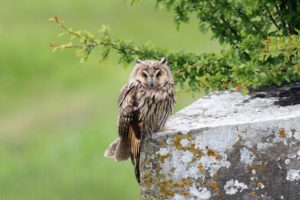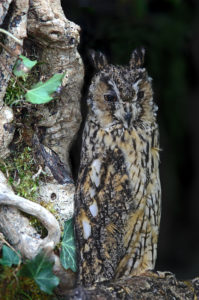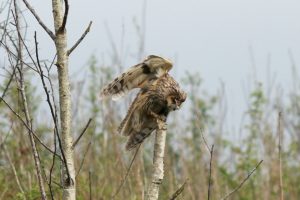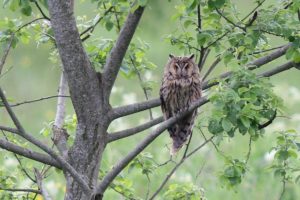
Local info | Description, habitat & diet | Breeding and survival | Gallery | Video
The long-eared owl is medium-sized owl, smaller in size than a woodpigeon. It often looks long and thin, with head feathers (known as ear tufts even though they are not ears) which it raises when alarmed. It is buff-brown with darker brown streaks, and deep orange eyes. It breeds thinly across the UK with fewer birds in the south-west and Wales. Northern birds migrate southwards, including birds from Europe coming to spend the winter in the UK, while southern birds are residents and only move short distances to find food.
In Gloucestershire
Records from the 19th century show that Long-eared Owls were breeding in dense conifer plantations on the Cotswolds, and that they were very scarce, with no breeding, in the Forest of Dean. They bred commonly in the Bourton-on-the-Water area until the 1930’s, when there was a sudden disappearance. No records followed in the county until 1975, and in 1979 a single breeding record was made. Nesting records have occurred in 5 years since then (most recently in 2002). Winter produces four or five records each year.
Size, habitat and diet
Length: 36cm
Wingspan: 95cm
Weight: M/F: 290g
World distribution: Breeds: Europe, N&C Asia, North America. Winters: N Africa, S Asia, C Mexico
Habitat: Coniferous & mixed woodland
Diet: Small mammals, esp. voles, also some birds. Nocturnal
Breeding and survival
Clutch size: 3-4 eggs
Incubation: 28 days
Fledging: 29-34 days
Number of broods: 1(2)
Age at first breeding: 1 year
Typical lifespan: 4 years
Introduction to the Long-eared Owl (Wild Owl TV)
[youtube https://www.youtube.com/watch?v=fVkp3c9AKis?rel=0&w=560&h=315]






